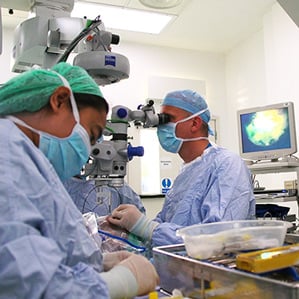Gene Therapy Tested as a Way to Stop Blindness
A new kind of gene therapy has reversed some vision loss in people born with a degenerative eye disease for which there is no existing treatment.

In a first for the field, the treatment can be given to some participants who still had 20/20 vision, albeit in a limited field of vision. By delivering gene therapy at an earlier stage, researchers hope to save more light-sensing cells in the retina.
“We need to push gene therapy forward, to apply it before vision is gone,” says Robert MacLaren, an ophthalmologist at the University of Oxford who led the study. “When retinal damage gets to a certain point, it’s beyond repair.”
MacLaren says earlier treatment could also be particularly important for conditions such as retinitis pigmentosa and age-related macular degeneration.
The surgical procedure employed put the precious remaining vision of patients in the trial at risk because it involved detaching delicate retina tissue in one of each participant’s eyes, but so far no problems have occurred since that surgery, the researchers report. Some participants report that they’re now able to detect more light, read more letters and numbers, and even see the stars at night. One patient, who before his treatment could not read any lines on an eye chart with his most affected eye, was able to read three lines with that eye following his treatment.
The condition addressed in the work is choroideremia, an eye disease that affects an estimated one in every 50,000 people. Because the gene that causes this disease is on the X chromosome, it primarily affects males. Starting in late childhood usually, the condition causes progressive narrowing or tunneling of vision and often ends in blindness. The condition gradually wipes out the light-detecting rods and cones in the retina.
The experimental treatment adds a working copy of the culpable gene to the retinal cells of patients born with a defective copy. The trial also involved an experimental way of delivering gene therapy to the eye. Each patient’s retina was first lifted, and the gene therapy was injected into the space created under the retina. MacLaren and colleagues report on the condition of six patients in a study published on Wednesday in the Lancet.
Other groups are also developing gene therapies for retinal diseases. This includes a group at Children’s Hospital of Philadelphia, which recently funded a new company to continue human trials of a treatment for Leber’s Congenital Amaurosis, another inherited form of retinal degeneration (see “New Gene Therapy Company Launches”).
Researchers Hendrik Scholl from John Hopkins University and José Sahel from the Institut de la Vision in Paris write in a commentary accompanying the research paper that since the surgery was performed only six months ago, it is too soon to determine if the therapy has achieved an important goal: to stop the loss of retina tissue.
“It’s going to take a couple of years to be sure,” says MacLaren.
Keep Reading
Most Popular
Large language models can do jaw-dropping things. But nobody knows exactly why.
And that's a problem. Figuring it out is one of the biggest scientific puzzles of our time and a crucial step towards controlling more powerful future models.
How scientists traced a mysterious covid case back to six toilets
When wastewater surveillance turns into a hunt for a single infected individual, the ethics get tricky.
The problem with plug-in hybrids? Their drivers.
Plug-in hybrids are often sold as a transition to EVs, but new data from Europe shows we’re still underestimating the emissions they produce.
Stay connected
Get the latest updates from
MIT Technology Review
Discover special offers, top stories, upcoming events, and more.